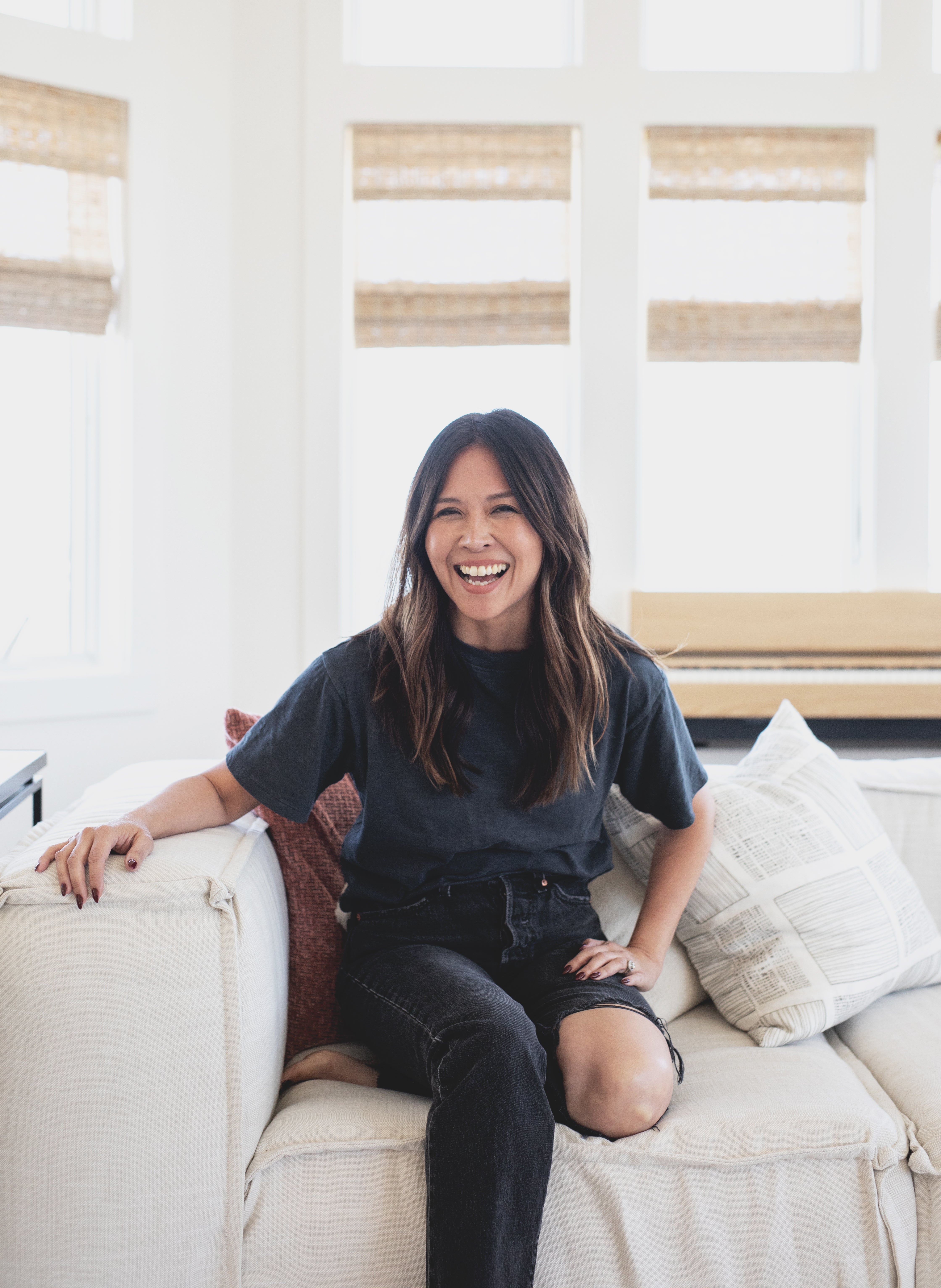The 50 States Project is a series of candid conversations with interior designers across the country about how they’ve built their businesses. This week, Manasquan, New Jersey–based designer Christina Kim tells us how a stint in retail gave her an industry crash course, why she’s growing her firm so that she can keep designing, and the biggest misconception about second homes.
What was your path to becoming a designer?
I was, like, 32 before I even knew I could draw or that I was creative. I’ll tell my kids, “Oh, you’re a great artist,” but nobody was telling me that. It was a really curvy path: I went to the University of Southern California—I was a broadcast journalism major—and then I left college. My dad had passed away suddenly, and it just totally changed my career path. I decided life’s too short, I do not want to be a journalist, I actually don’t even want to be in college. I went to New York—I had this pipe dream. I had always wanted to be an actress, and I was going to go and try it, thinking, “It’s now or never.”
In the beginning, as I was getting my agent and trying to find my way into SAG, I worked the nightlife in lots of super fashionable places, and the design was just dazzling. It was the first time that design and my environment really just stopped me in my tracks. I didn’t grow up going to homes that were like, “Wow, this is a knockout,” but certain restaurants or hotels in New York really stopped me, and I thought, “Someone put this together—this is fabulous. How do I do this?” That was my first inkling of design.
How long did you stay in New York chasing that acting dream?
Four years. Through my 20s, I moved every few years, from New York to Los Angeles, and then I was in Paris for a while, so all those experiences really informed the lens through which I see design. It was a winding [path] of chasing some sort of creative [dream] that I did not yet understand. I was too young; I didn’t have the vocabulary. I didn’t know what I was looking for yet. Then, year by year, you realize what you’re attracted to: “I could be working on this monologue, but what I really want to do is look at furniture. I want to drive and see cool buildings in L.A. I want to imagine what 1920s Hollywood was like.” It was just sort of paying attention to that [internal shift].
What was the moment when you pivoted toward design?
I had settled in Matawan, New Jersey, started having kids, and my husband and I renovated an old house that was in his family. It was a 100-year-old house, and we didn’t have the budget to hire anyone, so we did everything ourselves over a two-year period, and I just loved the experience so much. For example, once we got into tile, I’d want to know everything there was to know about it and how it was supposed to be installed—and every piece of the construction process was like that. I fell in love with renovation, and by the time the decorating part came, I was just completely smitten. I didn’t even really have to think, “Do I want to do this for a living?” There was a moment when it all sort of clicked, like, “This is what I’m supposed to do.” Every party in some great house I’ve ever been in, every restaurant where I’ve ever really admired the design—it all led to here.
I decided I want to learn as much as I could, so I ended up going to a local community college. I had little kids; I wasn’t going to be able to jump on a train and go to Parsons, so I did that instead, and it was really fabulous. I learned so much. I didn’t realize that there were so many designers locally. Two hours outside of Manhattan, there was a burgeoning industry here in New Jersey, and I had no idea. It made me feel very optimistic, like, “Wow, I can be part of something,” and it’s not just me trying to invent a profession in a place that didn’t care about that. There was already design here, I just didn’t know it.
After design school, how did you jump into a design career?
We sold my husband’s family home in Matawan, and then built a house there, so then I learned a little bit about new construction as well. And then after school, I worked for a high-end residential furniture showroom and learned a lot. I really recommend it—retail is maybe not fun to work in, but six months of working in a high-end furniture showroom will teach you a lot about pricing and wholesale, and the lines that you have to work within. Without that, you don’t have a toolbox yet, and you need that toolbox. It’s like a crash course in furniture.
One of the designers at the showroom broke out on her own in Red Bank, New Jersey, so I jumped on board with her, worked with her assistant and learned a lot, and then I went out on my own in Manasquan, on the Jersey Shore, in 2012.
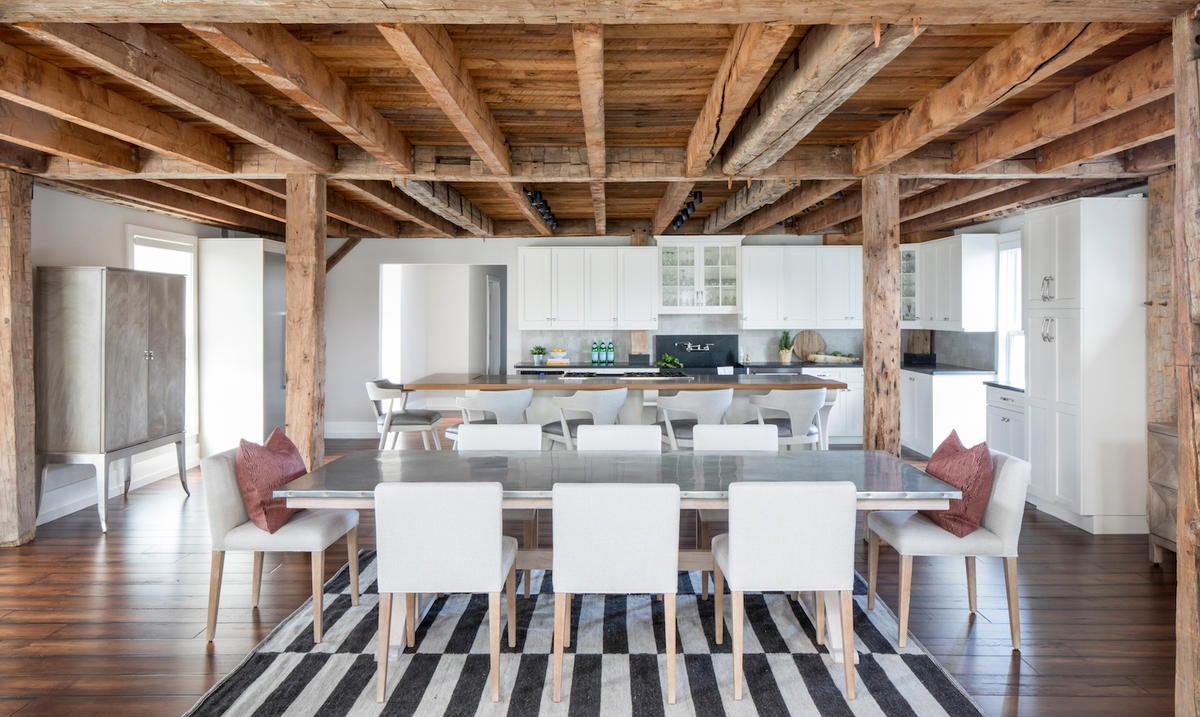
Where did the first client come from?
Through a friend. In the beginning, I would just do things on the side—a lot of it was for other designers. Did they need a hand rendering? I would do it. Did they need help with the CAD drawings? I would do it. Did they need help sourcing things? I would do it. Then, suddenly, a fashion stylist friend came to me and said, “I have a great client, and she’s going to need help with her whole house. Are you ready yet?” I thought, “You know what? I’m ready. I’m going to try.”
I poured myself into that experience and used it [to get my business off the ground]: “OK, I’m going to set myself up as an LLC. I’m going to get a template for my invoicing. I’m going to open accounts.” I also learned about sales tax. Looking back, [that whole process] was a lot of fun—[although I was] sort of working in darkness because information wasn’t as readily available for all that stuff. I feel like now you can just Google it, or call a designer, or reach out to a designer on Instagram, and probably they’d be more than willing to give you the information if they have time. But back then, it certainly wasn’t like that, so that was a lot of fun.
I thought that once I had that project under my belt, jobs were going to come rolling in, but I really still had to chase them. There was a period where I just kept business cards with me anywhere we were. I would even take them on vacation. [I was selling services for] anything that clients might need help with, [from choosing] a paint [to designing] a room. [My projects] were all so different. It could be a room in a Victorian house. It could be a basement renovation, a bathroom, or sourcing tile or reupholstering a piece of furniture. I would do any of it until it led to bigger things. It was very step-by-step. I was looking around at my local colleagues, thinking, “They’re pretty consistently busy, [whereas for] me, it’s either I’m really busy or not busy at all.” Those times when I didn’t have clients, I used to learn something, to get better at a program or CAD, or [brainstorm and educate myself on] how I was going to build the next time. It’s like anything—if you’re moving toward it, it’ll come to you. It’s definitely not an industry where you can just sit and hope.
How did your firm grow and evolve over time?
It was just me for a long time, and then I noticed I had the most success when there was a construction element to the project, so I eventually needed help with drawings. There was someone I went to school with who was the best at drawings—she was just so fast, she really understood it, and she would be tutoring everyone else. Well, I hired her, and she’s still with me as our construction designer, and she’s such an integral part of my business. We started off doing smaller things, like, “Let’s do a custom bunk bed,” and I’d sketch it out and then we would collaborate on it, and in a short amount of time we could design something pretty great. We still work like that.
When did you start collaborating?
Probably 2014—and I recommend that [kind of collaboration] to everyone. I knew how to do drawings at that point, but she was better, and that freed me up to do other things in the business that needed doing. You can make more money that way. It’s like buying time.
Were you worried about whether you could afford to hire someone?
No, because at that point I was billing exclusively hourly, so I learned, “OK, I’m going to pay for drawings from a designer on a freelance basis at first, and then I’m going to work that into my hourly rate,” and we learned to do that, and you have to.
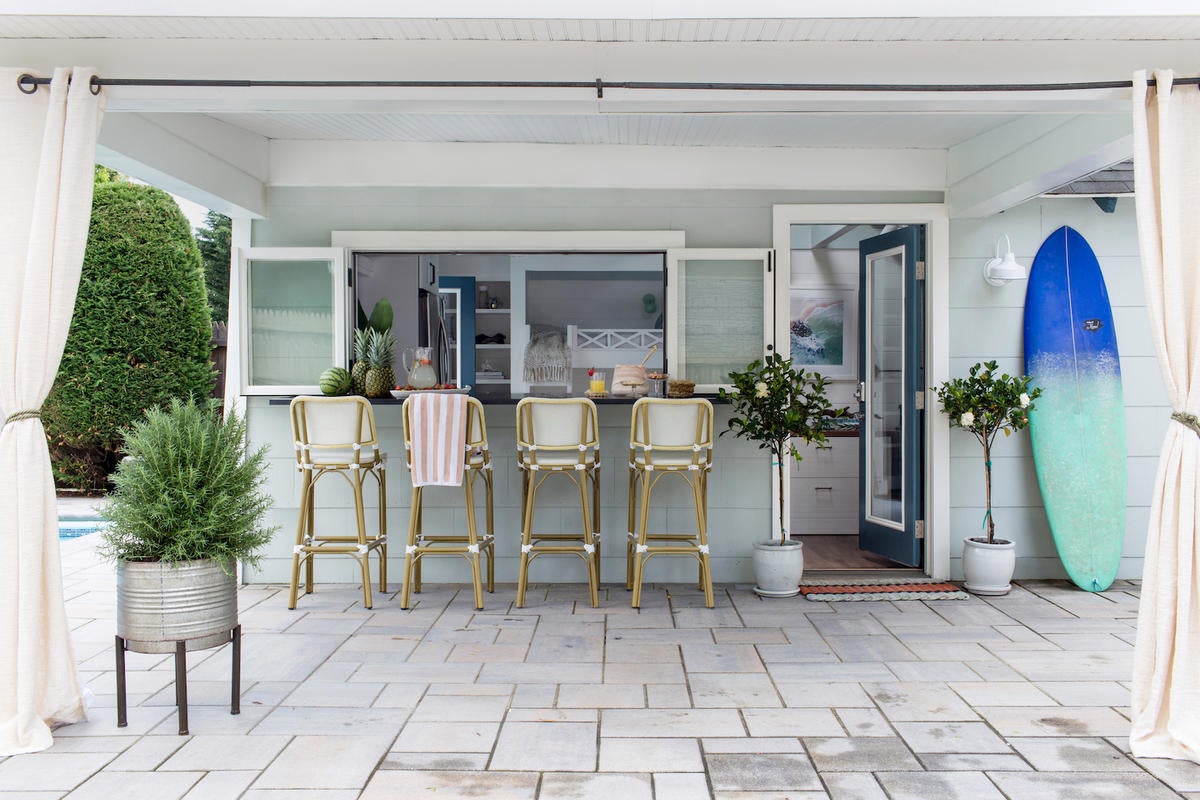
How do you bill today for your work?
We still bill mostly hourly, with the exception being some new construction where we bill a price per square foot for design, and then [adding] a percentage over that budget for project and purchase management. If you can control the project, that is a very effective way to bill, to close a deal, and to have somebody sign on with you. But your processes have to be so tight to bill a flat fee because you can easily lose your shirt. I would say it takes years of billing hourly and tracking hours to be able to even attempt a flat fee.
When did you decide you were ready to change to that system?
A few years ago, I realized if I were a client I would be frustrated too, if I had this giant project, building a house and spending so much, and I couldn’t budget for the interior design piece. Because interior designers are often the first ones in and the last ones out of the project, and if your clients don’t know what it’s going to cost, that’s hard, and you’re setting yourself up for a lot of conflict in the worst-case scenario.
Once I had enough historical data—like this is how many hours it takes to complete a 6,000-square-foot new build—I attempted it. There were times when I thought, “I probably would be making more hourly on this project, let me change this or that.” So I fine-tuned it, and sometimes for those jobs I still do bill hourly. It’s one of those questions that won’t go away: How should we bill? I think you can have a smooth project and that’ll change your mind, and then you can have a rough one and that’ll change your mind right back to where you were before.
Are you feeling pretty settled and set in your ways now?
Always changing, always looking for best practices. That’s one thing my team will make fun of me for. I’ll have a free moment, and I’m like, “Guys, I just listened to a podcast on sales tax,” and they’re like, “That’s so riveting. It’s really riveting, Christina.” But I’ll take one little nugget and change something, or put a call in to our bookkeeper and say, “Am I doing this right? Is there a better way to do this?” That’s the thing—you’re always trying to get better, be more effective, nimbler, and try to do the best work that you can all the time. So, while we are set in our ways, and I think we do have really great business and design practices, I’m always looking to get better.
How do you talk to clients about what design is worth or what design costs?
What works a lot in new construction is to have historical information. Not only will I talk in terms of design fees, like a price per square foot, I will also speak that way for new construction in terms of what it costs for furnishing. It’s important to me to have big numbers in my head—like good, better, best, complete furnishing, what’s that going to cost? I ought to be able to give them a good range, because if they can’t even enter that range of pricing, then we’re going to have a problem on both ends. I think that’s really important, and I spent a year trying to get that information, but once I had it, I could speak to clients really confidently: “This is the square foot range it’s going to cost for design; this is the square foot range it’s going to cost to furnish.” That was a game changer.
So clients were OK with the prices, they just wanted to know what it was ahead of time?
If they were our clients to begin with, they would be OK with it and really appreciate that information. They also develop a trust right away, like, “OK, you’ve done this before. This is what you say it’s going to cost. OK, I can meet you there.” Then there were clients who said, “Thank you so much for that information and for your time, but it’s not going to work.” They don’t have the budget but would rather know right away.
Do you have a minimum budget requirement, or is it more about assessing job by job?
It’s less about a dollar amount than it is about [figuring out] what it’s going to cost to design and furnish these spaces, but we have a one-floor minimum. There’s always more than that, but that’s our minimum, and they have to check off all these other boxes to make sure they’re the right client for us, and we’re the right firm for them.
It takes so much confidence to be able to say, “You know what? Not everybody is for me.” When did you start to focus on that?
In 2020. In the early days of the pandemic, it was so busy, and quite honestly, I put my firm under a lot of stress. I took too many jobs. I staggered them, thinking that would work, but everything was taking so long. Ideally, you should be finishing up certain projects, and then new ones start, and you start in a different phase of the project, but [they weren’t] falling off our roster. In 2020, I couldn’t complete a project—they just took forever, so at one point there’s a team of four of us, and there are, like, 14 projects, and I just wanted to die, to be completely honest. I thought, “I don’t see a way out of this,” and then once I finally did complete a lot of those projects, I could think more clearly. I went away on vacation, and I came back totally with a different head. I thought, “I’m going back to what I focused on in the beginning of this business,” which was two things: I knew I wanted to produce quality, and I knew that I wanted to be in on the construction phase and take it all the way through, and that’s it.
Now, 2022 looks a lot different. We run, like, five big projects at a time, so at any given moment there are five new builds, or complete gut renovations that we’re seeing all the way through to furniture and styling, and we’re in different phases and it works. If I can pop in [smaller] furniture projects in between, I will, but I know better than to do what I did in 2020.

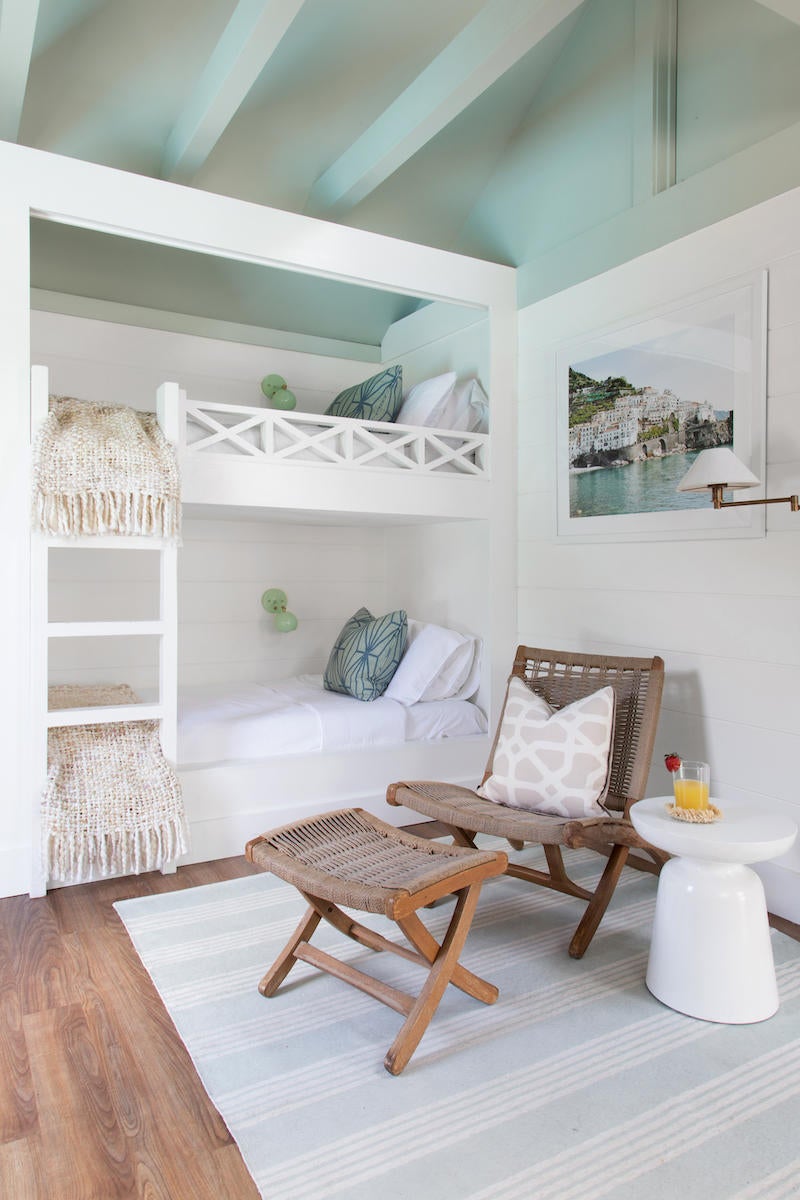
What does your team look like today?
I’m the principal—I still lead every project all the way through. Our construction designer, Felicia, is in charge of anything attached to the walls, whether it’s cabinetry or lighting plans or plumbing. Then we have Ally, our junior designer, who assists with both the construction side and the decoration and furnishing side. Bonnie is our project manager—she is really, like, the connective tissue. I don’t know how we ever worked without a project manager. And we also work with a bookkeeper.
I probably should have hired another designer by now—we really need a senior designer, so that’ll be in the works this year—but I’m generally pretty slow to hire [because] we work so collaboratively that it has to really fit. And I still want to design—we have enough work for a bigger staff, and [even] bigger if we wanted to take more jobs, but that would mean I would be managing more and designing less. I don’t see anything wrong with that, and maybe one day I will do that, but right now I still want to design.
What does that mean on a day-to-day basis? How hands-on are you with each job, and where do clients see you versus your team?
I’m in every major meeting, but I tell clients from the jump that communication—status emails, or if we’re problem-solving—is probably not ever going to come from me unless it’s a major thing, and I need to pick up the phone and call somebody. But while I’m not communicating all the time with our clients, I am often still the one calling the marble fabricator to work out a detail, and I am working on the design all the way through. I just realized early on that the client management piece of the puzzle takes a lot out of me, and I’m not the best person for that.
Was that an easy thing to let go of, or is it challenging to give away those touch points?
I had a really hard time, and I have to say, I was really clumsy about it. In the beginning, when I first started to delegate more, I had to just say to myself, “OK, Christina, we are not going to micromanage, and we’re not going to explain.” Even when mistakes happen—if a team member made a mistake, I let them own it, and I own it. I delegated this to somebody that is capable, and they are not a robot, so they are sometimes going to make a mistake, and so am I. Now I just say that up front.
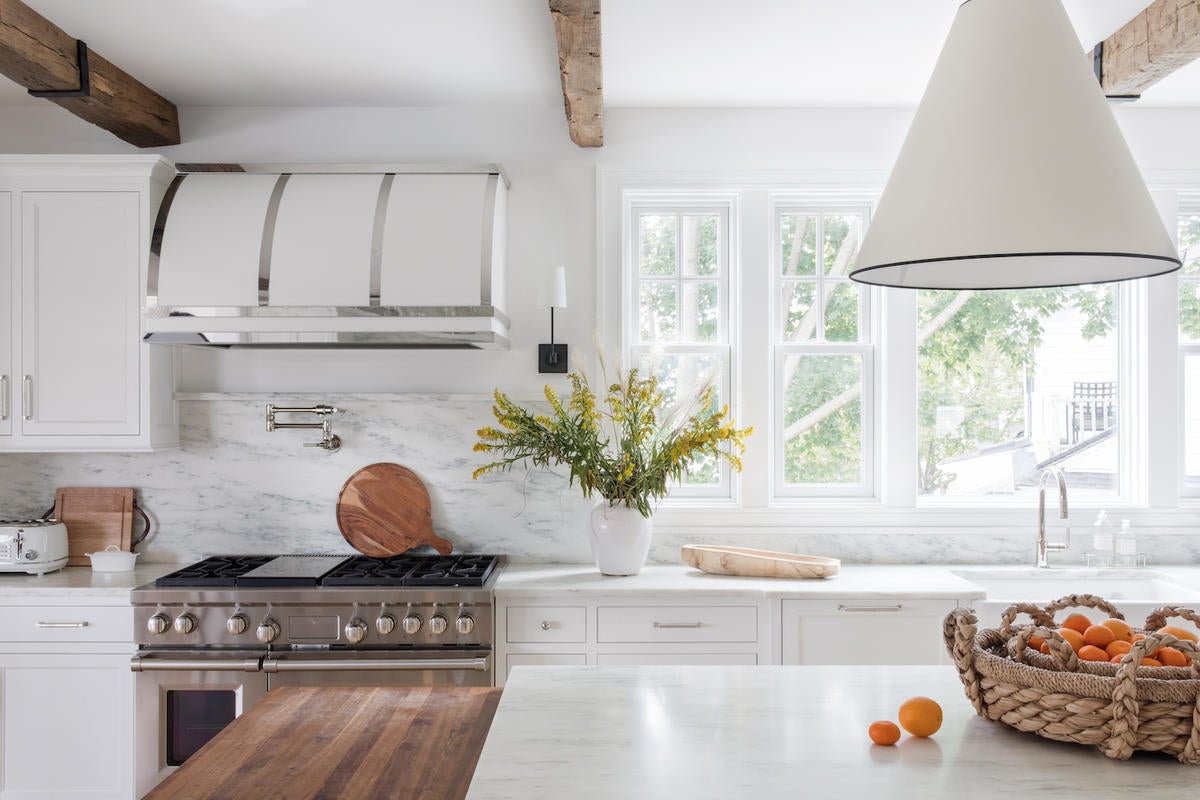
Can you tell me about the design scene on the Jersey Shore?
Oh, boy, has it changed. It had been changing in the past five years—and then during the pandemic, people were leaving Manhattan in droves. Either they already had a property here at the beach or they were looking to buy one because they could work from home, their kids were in remote school, and they wanted to look at the ocean while they did that. That’s when the renovation side of the business ended up going crazy, because there wasn’t a whole lot of inventory, so people were just fixing what they had and making it work.
It’s wild, because all of these little towns are so small, and they’re so close to one another, but each one has a totally different personality and a totally different real estate landscape. About half of our clients are full-time residents in these beach towns. The other half are vacation homes—a lot of them have multiple properties, but they love coming here for the old-school beach town lifestyle, and they want to give that to their children and grandchildren. It’s about creating an environment that’s going to be in their family for the next 100 years.
How do you approach primary residences versus family vacation homes?
There’s this misconception about beach houses—that you get to have more fun with the design there because you don’t have to think so much about what’s practical—but I find it to be quite the opposite. I think you have to be more practical in a beach house, because people are really hard on their things at the beach. I live at the beach, so I get it. I’m vacuuming up the sand in the bed 12 months out of the year. And with materials, clients are like, “Yeah, but can I ride a bike over it?” They need things to be fun, yes, but also hard-wearing, which is a built-in challenge that I love.
It also forces you to become more creative, because you also don’t want to do the same thing all the time. I just had a builder reach out to me, because they made a wood countertop and poured resin through the cracks, and it sealed so nicely that we can use it for outdoor countertops under a covered area. I was nerding out about it. I’m always looking for how to use some humble material in a new, cool, elevated way.
What kind of resources are available, or where do you go to shop?
We go to trade shows like High Point Market and NY Now. I also have a few custom workrooms or tradespeople who can make certain things for us. Our stone fabricator is invaluable—we can just draw something, and they can make it. And then I love 1stDibs, Chairish and LiveAuctioneers. And Etsy and eBay. I’m the person with a timer set on my phone for the middle of the night, because there’s an auction for this cool 1950s vintage Italian chandelier. I feel like every room needs at least one or two pieces that are vintage or completely bespoke. It doesn’t even have to be that it’s such an expensive thing. It’s just that that’s what’s going to make that room different for both you and your clients—an original.
How does sourcing vintage fit into your workflow and the way you present?
That’s a timely question, because it’s something we’re working through right now. Our design presentations are super organized: I have everything priced, along with lead times, all the finishes and the fabric memos—anything you need to be able to make a decision and see the design that we’re envisioning. But you can’t do that with vintage. I did this experiment where I said to a client, “Hey, we could build this entire upstairs lounge around these two 1970s vintage chairs, are you in?” And they said no, just because they don’t have much time to decide whether they want it and can’t look at it in person. So I’ve just leased a very big storage space that I’m quickly filling with vintage pieces that I love. Obviously, that’s not always possible—or if it’s a very big-ticket item, then it’s a leap of faith. We do have some clients who take that leap with us, but you have to read your client, and not everyone has that personality. The pieces in the storage space are for them.
Are you going to build warehousing and inventory into the cost of doing business?
Yes. You have to balance what’s good for the business with the creative, and you have to make that work. It’s this dance all the time—we have minimum spends in order to maintain a certain level of pricing with our vendors, and I’m very conscious of that, but at the same time, you don’t want the design to get stale. And it can. Your business can be doing so well, and the design can get stale because you’re pulling from the same manufacturers or filling projects with all new, freshly fabricated furniture. It’s those bespoke touches that make it yours. There was a period where we were so busy that there was less of that, and I recognized that although the designs were great, they were not that exciting for me. I need a piece to hunt for to get inspired.
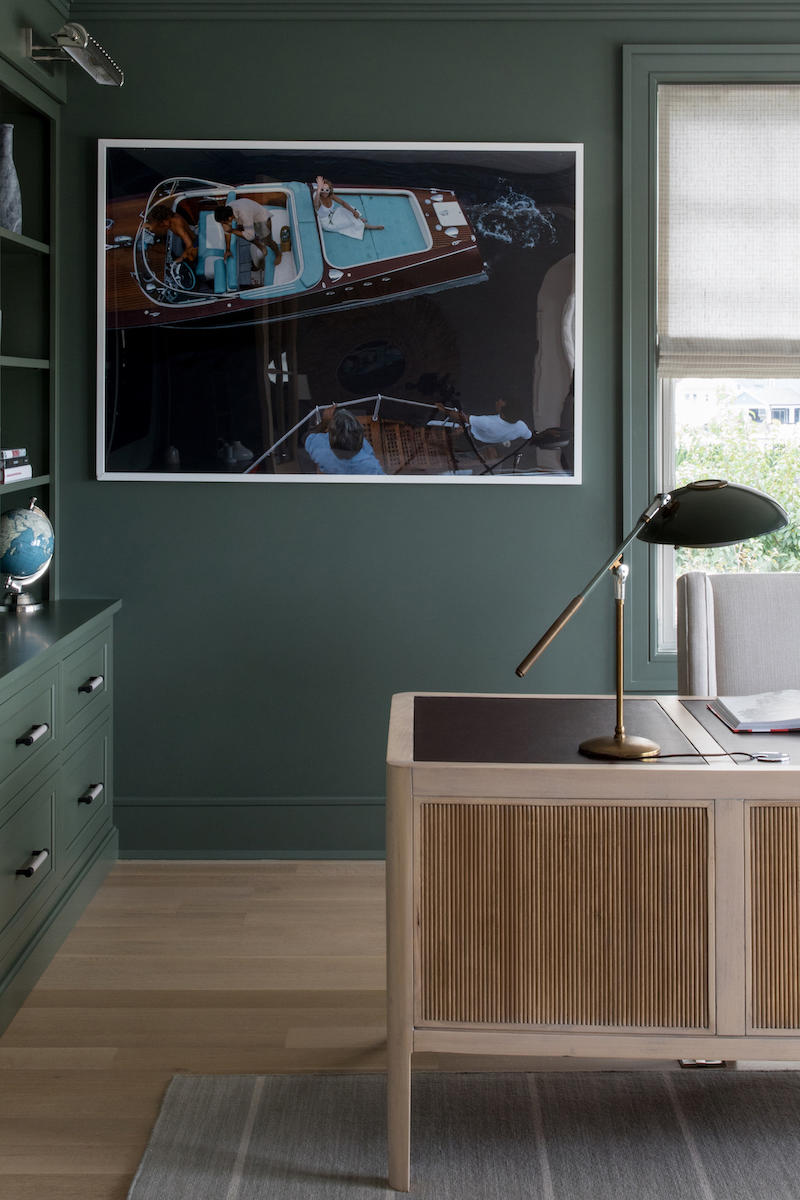

What comes next for your firm?
We are working on the Kips Bay [Decorator] Show House in Dallas, and that has been so fun. It’s been so reenergizing as a designer because we have to pull out the best designs we’ve ever done—and so quickly. There’s no time to really second-guess what you’re doing, you just have to do it. There was a lot of feeling that way when I first started [my business]—that sense of, “Just figure it out”—but that feeling can kind of get lost along the way. What I really learned from this experience is that I love to be able to pour myself completely into a design in the beginning. I can't wait to apply that to my day-to-day operations in the firm.
You had to do that for the showhouse, I’m guessing, just because the timeline was so tight?
Exactly—and it’s really how I used to work before. But that changed once we were juggling so many projects. I want to apply that again, because it’s so useful. It’s hard to block out all the noise to concentrate on just one project—to shut off all the emails and not worry about another project—but I got so many great ideas by being holed up in my hotel room in Dallas just working out the design.
How do you start to apply that to your firm in the future? Do you block out a week where you don’t do anything else?
I don’t know that I could block out all five days of the business week, but what I’ve learned from Kips Bay is that I’m going to block out two weeks when we’re majorly focusing on the design concept for this project, to really get to know it, because then the wheels are already turning so hard that you can’t help but have ideas. A lot of those ideas you throw out, but you just have a lot of them when you’re thinking so deeply about a project.
Is your team part of that process, or is that an introspective solo thing for you?
It’s introspective and solo for a bit, and then I’ll bring my team in and tell them where my head is at. Then they’ll take those ideas and riff off of them, and we’ll sit together to edit. It’s, “That’s not going to work because of X, Y and Z, but I love this,” or, “I’m obsessed with oxblood right now. How could we work that into a beach house?”
Oxblood at the beach is a fun design challenge. If you’re designing mostly beach homes, how do you keep that from being limiting aesthetically?
You have to always be trying to level up your design—and like I said, bespoke and vintage are a huge part of that. I’m always thinking, “Can I find a vintage piece of art that would set the tone for this entire room, or even the entire project?” It’s about looking for that one sort of weird factor or incongruent detail—like using oxblood. I might not be able to, but it’s in the challenge of doing something that doesn’t seem very obvious at first and forcing yourself to find solutions. I think that’s a discipline, too: How do we do something that we haven’t done? What do we want to explore now?
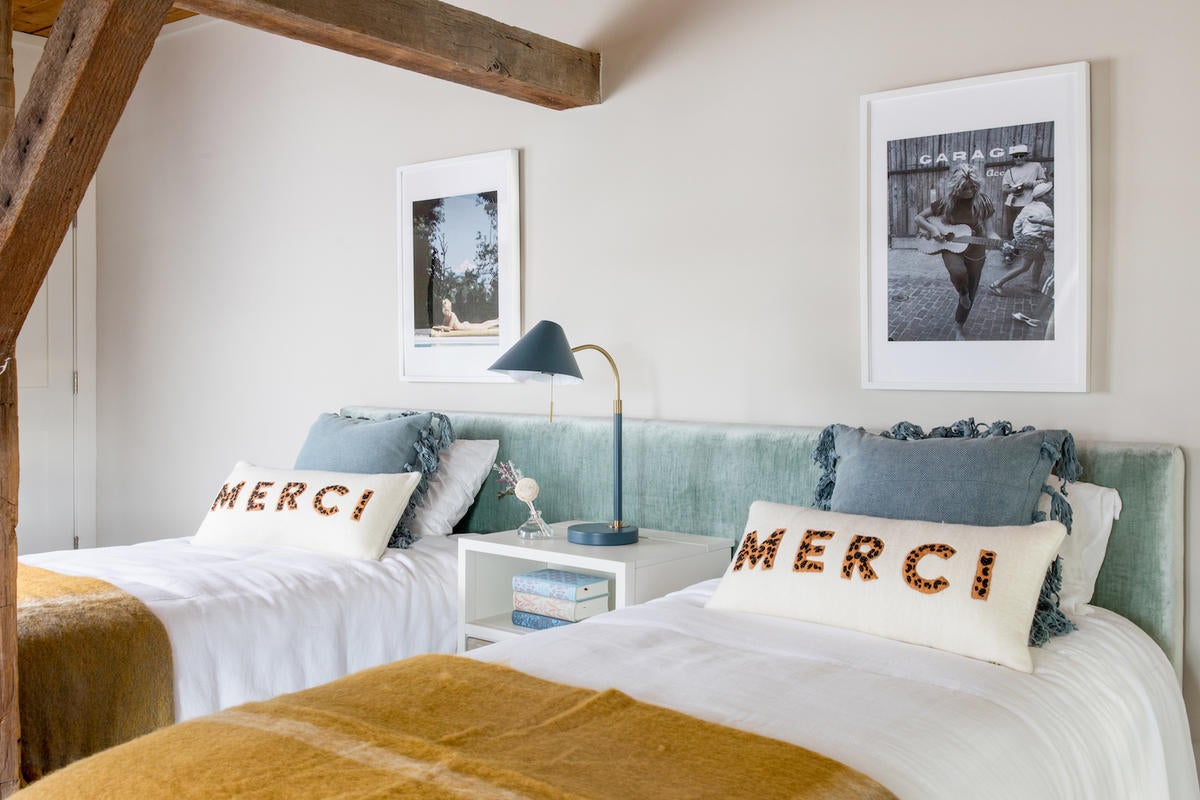
What do you want to explore now? What does success look like for you these days?
For me, success is having trusting clients who are willing to take risks joyfully with us—and also not working on a hamster wheel 24/7 so that I’m able to see my kids. But now, it’s also to be able to successfully work at a distance—to take projects in other places and feel really good about the process. That’s our focus right now. Working on the showhouse in Dallas opened up possibilities. It made me realize, “This is doable. We could do this.” I just have to fly in at a couple key moments of the project.
What is the biggest thing you know now that you wish you had known when you started your business?
I wish I had known that I didn’t need all the answers. That’s something that people will tell you, but you don’t really believe it. I also wish I knew that it’s OK to be the one in the room asking questions. In the beginning, I would be so nervous—like, “They’re going to know that I don’t know the answer”—but it’s much faster to just ask the damn question, and people respect you for it. I’m constantly calling builders I’ve worked with, and I’m asking, “What do I do first when I’m ripping out this fireplace and putting a new one in?” And not only am I always asking questions, I’m always like, “Talk to me like a kindergartner. I need you to be slow and nice, and I might ask you to repeat it a few times.” I wish I knew that you could just ask, and to not worry about how you’re being perceived.
Another thing I’ve realized is that there are no shortcuts in this business. Even if you are getting a lot of good information, or asking the right people the right questions, you still have to give yourself a little grace—and a lot of time—to actually learn what you’re doing. That example about fireplaces, you’re still going to have to do a bunch of them to really get it, and that’s going to take time, but there’s such satisfaction in [gaining that] knowledge, and then you can focus on learning something new. But there aren’t any shortcuts, especially if there’s a construction element to your project, and you’ve got to give yourself time. Everything is long—to get content is long, to finish a project is long—and to learn from a mistake, you have to see the mistake through, learn the lesson, and then try not to do it again.
To learn more about Christina Kim, visit her website or find her on Instagram.
















